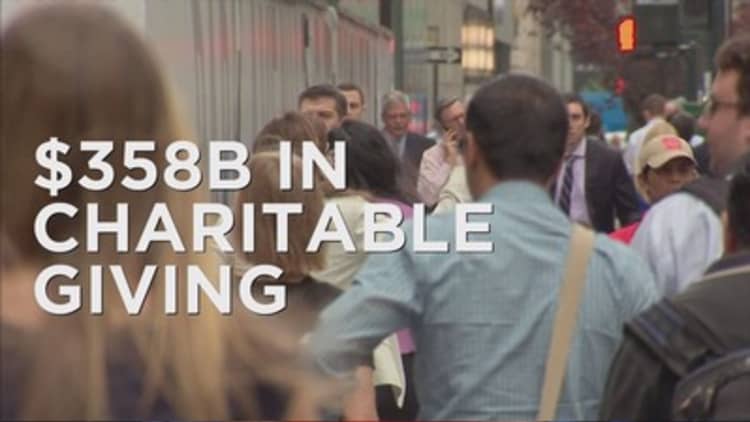
Americans' generosity hit new highs in 2014—kind of.
Charitable giving in 2014 totaled $358.38 billion, a 7.1 percent increase in current dollars, according to the Giving USA Annual Report, published by the Giving USA Foundation. Even adjusted for inflation, that figure represents a slight increase from the $355.17 billion given in 2007, before the recession.
That's great, as far as it goes. But giving has not increased significantly as a percentage of GDP in almost 20 years, hovering right around 2 percent all that time. Charitable giving in 2014 equaled 2.1 percent of GDP, up slightly from the year before, but the same as or just under the rate for 1999 to 2007.
In addition, individual giving in 2014 rose more slowly than giving overall, increasing 5.7 percent to $258.51 billion. And when that amount is adjusted for inflation, it is still below the $267.69 billion reached in 2005. (Tweet This)
Read MoreDonations rose in 2014, but this year may be different
Then there is the matter of donor-advised funds. In these funds, donors contribute and take an immediate tax deduction, and then dole out the money to charities as quickly or as slowly as they like.
Assets in donor-advised funds have been increasing rapidly, rising $17.28 billion in 2013. Four of the 10 largest charities are now donor-advised funds, according to the Chronicle of Philanthropy. One, Fidelity Charitable, is on track to pass United Way as the nation's largest charity. And some charity experts question whether they are truly enhancing philanthropy.
Ray Madoff, a professor at Boston College Law School, contended in a 2014 commentary that because the mostly affluent people who contribute to donor-advised funds reap an immediate tax benefit, but have no obligation to get their money to charities, "donors and the people who manage their money have been the primary recipients of benefits from the growth of donor-advised funds." In the meantime, she wrote, "Charities and the people they serve are being starved of resources."
Read MoreThe pros and cons of donor-advised funds
Experts say that roughly 15 to 20 percent of donor-advised fund assets are directed to charities every year. Kim Laughton, president of Schwab Charitable, put distributions from her organization at more than 20 percent. Those drawdown rates far exceed the 5 percent minimum rate that foundations have to meet. But Madoff and others say that is not an apt comparison.
Una Osili, director of research at the Indiana University Lilly Family School of Philanthropy, which conducted the research for the Giving USA report, pointed out that donor-advised funds provide an easy way for people to give appreciated securities that small charities in particular might not be equipped to handle. Fundraisers for nonprofits she has spoken to have warmed to the funds over the years, she said—but donor-advised funds may have downsides as well.
These funds, Osili said, can have "some costs if some of these assets are held in accounts and not necessarily redistributed back to the nonprofit sector."
The debate around donor-advised funds could conceivably quiet down because the pace of growth at some of the largest national donor-advised funds appears to be slowing. At Fidelity Charitable, contributions from donors increased just under 5 percent, to $3.8 billion, in the year ended in June 2014, down from a 14 percent growth in contributions the year before. Contributions to Schwab Charitable actually decreased slightly to $1.817 billion in the year ended in June 2014.
Read MoreFTC: Cancer charities scammed $187M from consumers
Charities can only hope that slowing growth will not translate into slowing support for them overall. But with the recession receding into the past, Osili pointed to reasons for hope.
More than two-thirds of all Americans give to charity every year, she said. "Philanthropy is such an important part of American civic and economic life."


